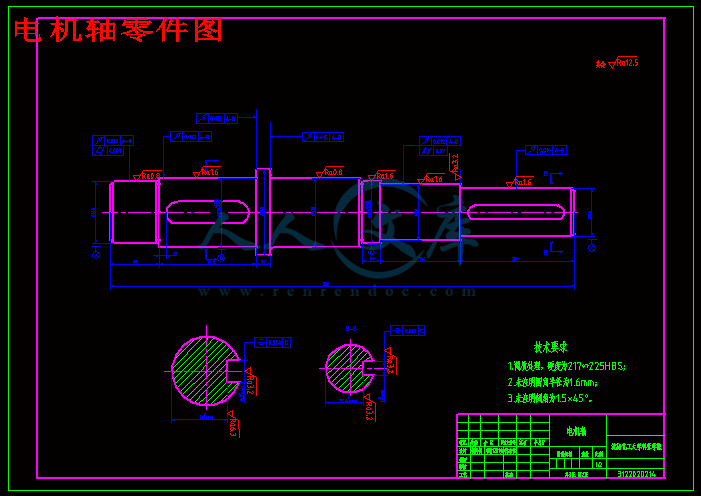小型为例重物提升机的设计(履带式起重机)
38页 14000字数+论文说明书+3张CAD图纸【详情如下】




小型为例重物提升机的设计(履带式起重机)论文.doc
小型为例重物提升机装配图.dwg
履带零件图.dwg
电机轴零件图.dwg
摘要
本文介绍了履带式起重机发展国内外的历史背景,分析了履带式起重机整体结构和工作特点,重点介绍了履带式起重机的重要参数,吊钩的设计,整体的液压体统,履带轮等相关数据。本文对原有的履带式起重机进行实验分析,然后根据实验的结果完成了对现有履带式起重机构进行结构优化和设计。新型的履带式起重机将原有的机械传动方式改为液压传动的方式;采用的履带式结构,使得起重机可以适应各种不同的工况地形,方便工作。
本文对履带式起重机进行了三维建模分析,对整体结构进行了分析,改进采用了液压装置,能很好的应用于机械工程中。
工程实践中吊装方案设计仍然停留在传统模式,采用手工校核方式选择吊索具、通过查阅性能表选择起重机、利用AutoCAD等常规二维绘图软件设计吊装过程等。这种传统设计方法严重依赖设计者的经验,需要多次迭代,设计周期长,吊装前无法全面、直观地查看动态的吊装过程。
在此背景下,计算机辅助吊装方案设计(CALPAD)技术应运而生。其中,起重机选型可快速选择合适的起重机,而路径规划及吊装仿真可直观、快捷地设计吊装过程并进行预演。然而,通过对比工程需求和现有研究发现:对应用广泛的桁架臂履带起重机选型较少;单机吊装路径规划未考虑起重机的行走;双机吊装仿真研究较少,现有方法待设置参数多且难以确定。由于大多现有研究缺乏对某些工程约束的考虑,
致使其难以真正应用到实际吊装工程。
为此,本文在多重约束下起重机智能选型、考虑行走的单机吊装路径规划、双机吊装仿真三方面开展研究并实现相应的软件,所形成的理论成果和软件已成功应用到实际吊装工程。本文主要研究工作如下:
1.给出了一种面向移动式起重机的多重约束起重机选型算法。首先构建了多重约束的起重机选型数学模型,基于此给出了选型算法的总体框架,然后以桁架臂履带起重机为例详细阐述了算法框架中起重性能、被吊物与臂架间距、接地比压约束处理的实现,最后通过实例验证了算法的可用性和有效性。与现有选型算法相比,技术上该算法将复杂三维空间距离计算问题转化为二维几何计算,降低了间距约束处理难度;该算法由于无需起重机、被吊物三维建模,在应用上更加便捷。
2.提出了一种考虑行走的单台履带起重机吊装路径规划算法。首先对规划问题进行数学建模,并设计了基于RRT-Connect++的吊装路径规划算法,给出了位形空间的定义、两位形间的距离度量、履带起重机非完整运动学约束的表达,最后通过三个仿真实验验证算法的有效性和性能,结果表明该算法能在各种复杂吊装环境中找到一条无超载、无碰撞可行路径。算法将履带起重机行走的非完整运动学约束融入算法中,使路径更自然、平滑。此外,其中的距离度量将长度量纲和角度量纲巧妙地统一起来较好地表达吊装路径长度,并且赋予距离度量直观物理意义,避免了为每个分量设置权重系数。
3.提出了一种基于空间几何约束的双机协同吊装仿真方法。针对典型吊装工况的双机吊装仿真问题,研究了双机之间的协同,设计了双机协同吊装仿真模型,给出了双机系统基本动作的表达与设计。通过实例验证仿真方法的可用性和有效性,结果表明该方法可容易地模拟典型工况的双机吊装过程。由于双机的协同策略已嵌入基本动作的实现,因此,在典型双机吊装中该方法吊装过程仿真更准确、仿真操作更简便。此外,该方法将两台起重机和被吊物看成一个完整的复杂系统称为双机系统),该概念为双机协同吊装的其它研究提供了一个全新的视角。
4.提出了一种基于正向运动学的双机吊装仿真通用方法。首先从静力学的角度探究双机吊装中起升系统部分的运动学规律,利用最小势能原理将起升系统部分的运动学抽象为带约束的数学优化问题,提出基于最小势能原理的起升绳偏摆角及起升力求解算法,通过与ADAMS仿真结果对比验证了求解算法的正确性。然后在此基础上设计了基于正向运动学的双机吊装仿真通用方法。最后通过实例验证方法的可用性和有效性,结果表明该方法是一种设计和预演双机吊装过程的有效手段。相比现有基于动力学的双机吊装仿真方法,该方法仅需被吊物的重心相对位置及重量即可准确求得吊装过程中被吊物位姿及起升力,为双机吊装仿真提供有力的支撑,可容易地嵌入吊装仿真软件中,实现实时的双机吊装作业仿真,具有参数少、实时等特点。
关键词: 履带式起重机;结构设计; 三维建模
Abstract
This article describes the historical background of the development of domestic crawler cranes, crawler cranes overall analysis of the structure and operation characteristics, focusing on the important parameters related data crawler cranes, hook design, the overall hydraulic decency, track wheel. In this paper, the original crawler crane experimental analysis, and then complete the existing crawler crane mechanism and structural design optimization based on experimental results. The new crawler crane to the original mechanical transmission hydraulic transmission mode; crawler structure used so cranes can adapt to different terrain conditions, to facilitate the work.
In this paper, crawler crane 3D modeling analysis, the overall structure is analyzed and improved using a hydraulic device, it can be well used in mechanical engineering.
Engineering practice lifting program design still remain in the traditional mode, manually checking mode selection sling, crane selection by referring to the performance table, the use of conventional two-dimensional drawing software AutoCAD and other design lifting processes. This traditional design approach relies heavily on the designer's experience, require multiple iterations, long design cycles, not fully before lifting, visualize dynamic lifting process.
In this context, computer-aided design lifting (CALPAD) technology emerged. Among them, the crane can quickly select the appropriate selection of the crane, and hoisting path planning and simulation can be intuitive and quick lifting process design and preview. However, by comparing the project needs and existing research found that: the application of a wide range of lattice boom crawler cranes less selection; single lifting crane walking path planning is not considered; less simulation of dual-lifting, the conventional method many parameters to be set and it is difficult to determine. Since most existing research projects lack of consideration of certain constraints,
So that it is difficult to apply to real actual hoisting.
In this paper, crane under multiple constraints intelligent selection, consider walking path planning lifting single, dual lifting three simulation research and implement the appropriate software, theoretical results and software form has been successfully applied to the actual hoisting. The main research work are as follows:
1.Shows the multiple constraints crane selection algorithm for mobile crane. First, we constructed a mathematical model of multiple crane selection constraints, based on this selection gives the overall framework of the algorithm, then lattice boom crawler crane for example detail the algorithm performance lifting frame, hanging objects and arm spacing, ground pressure constraint implementation process Finally, an example to verify the availability and effectiveness of the algorithm. Compared with the existing selection algorithm, the algorithm will be technically complex three-dimensional spatial distance computation problem into a two-dimensional geometry calculations, reducing the spacing constraint difficult to deal with; the algorithm because no crane was lifting three-dimensional modeling objects in the application more convenient.
2. The proposed consider walking a single crawler crane hoisting path planning algorithm. First planning mathematical modeling and design based on RRT-Connect ++ lifting path planning algorithm, gives the definition of the configuration space, the distance measure between two shaped expression, crawler cranes nonholonomic kinematic constraints, and finally availability and performance through three simulation verification algorithm, the results show that the algorithm can be found in a variety of complex environments without lifting overload, collision-free path feasible. Algorithm nonholonomic kinematic constraint crawler crane walking into the algorithm to make the path more natural, smooth. In addition, where the distance metric length dimensions and angle dimension subtly unify better expression lifting path length, and the distance measure gives intuitive physical meaning, avoid setting the weighting factor for each component.
3. The proposed based on dual-lifting collaborative simulation geometry of space constraints. For typical simulation for dual-hoisting hoisting working condition, collaborative research between the two planes, designed dual-lifting collaborative simulation model are given expression and design of the basic operation of the dual system. Examples of the availability and effectiveness of the verification by simulation method, the results show that this method can be easily simulated dual-lifting process typical operating conditions. Since the cooperative strategy is embedded dual machine to achieve the basic operation, therefore, in a typical dual-lifting in the lifting process simulation method is more accurate simulation easier to use. In addition, the method of two cranes and hanging objects as a whole complex system called dual system), the concept of Double other aircraft Cooperative hoisting provides a fresh perspective.
4. Proposes a forward kinematics of the double ceiling mount Common Simulation Method. First, from the point of view of statics inquiry Duplex Lifting lifting system from the kinematics law section, the principle of minimum potential energy will play a part of the lifting system kinematics abstract as a constrained mathematical optimization problem, since the principle of minimum potential energy of hoisting ropes yaw angle and lift from the algorithm, with the ADAMS simulation results verify the correctness of the algorithm. Then on the basis of the forward kinematics design double ceiling mount Common Simulation Method. Finally, the availability and effectiveness of the verification method for instance, the results show that the method is an effective means to design and preview dual-lifting process. Compared to conventional dual-based dynamics simulation hoisting method, which only needs to be the center of gravity relative to the position and weight of the hanging objects can be accurately determined during the lifting posture and hanging objects from the lift for lifting dual-emulation provided strong support, can be easily embedded hoisting simulation software for real-time dual-lifting operation simulation, with less parameters, real-time characteristics.
Key words: Crawler Crane; The Structure Design; Three Modeling
目 录
第一章国内外发展现状 2
1.1国外履带式起重机发展现状 2
1.1.1 利勃海尔公司 2
1.1.2 特雷克斯德马格公司 2
1.1.3 马尼托瓦克公司 2
1.2 国内履带式起重机发展现状 3
1.3 履带起重机的发展趋势 3
第二章 履带式起重机的重要参数 5
2.1 起重量Q 5
2.2 工作幅度R和有效幅度A 5
2.3 起重力矩M 5
2.4 起升高度H 6
2.5 工作速度V 6
第三章 吊钩的参数设计 8
3.1 吊钩的结构设计 8
3.2 吊钩的类型及其选择类型 9
3.3 吊钩尺寸的设计计算 10
第四章 发动机的选择及其发动机发热条件 13
4.1 发动机的选择及发热条件 13
第五章履带式起重机液压系统 14
5.1液压系统整体介绍 16
5.2 整体的性能分析 16
5.3 液压传动总结 17
第六章履带式起重机操作注意事项 18
第七章基于Solidworks软件进行的建模及装配 22
7.1 Solidworks软件建模与装配概述 22
7.2 运用Solidworks软件进行零件设计 22
7.3 运用Solidworks软件进行零件装配 25
第八章 结论与展望 26
8.1 结论 26
8.2 展望 27
参考文献 28
致谢 29
第一章 国内外发展现状
起重机是指在一定范围内垂直提升和水平搬运重物的机械设备。又称成为吊车等名称。其中起重机分为行驶驾驶室与起重操纵室合二为一,它是由履带起重机演变而成的,将行走机构的履带和行走支架部分变成有轮胎的底盘,克服了履带起重机履带板对路面造成破坏的缺点,属于物料搬运机械。
本文主要介绍了履带式起重机的相关结构特点及其应用。对履带式起重机的相关特点给出了相关的介绍。其中目前的发展现状如下:
1.1国外履带式起重机发展现状
在世界上起重机的发展已经有了很长的历史了,其中在发达国家的发展地主要由以下几个:主要生产国为德,美,日,法,意大利,世界顶级公司有10多家,世界市场集中在北美、欧洲和亚洲。
1.1.1 利勃海尔公司
利勃海尔家族企业由汉斯利勃海尔在1949年该公司的第一款成立,易于组装和负担得起的塔式起重机是一个巨大的成功,成为公司蓬勃发展的基础。今天,利勃海尔不仅是领先的工程机械制造商在世界之一,它以创新的产品和客户技术服务供应商很多方面是公认的。
1.1.2 特雷克斯- 德马格公司
自1988年以来在中国的合资企业以来,特雷克斯一直致力于业务在中国的发展,他在包头,常州,上海,泉州,漳州等地设立了多家独资和合资公司。特雷克斯积极为中国工业、交通和城市建设等支柱产业的建设提供高技术、低成本、绿色环保的解决方案,在中国销售的第四台3200吨级履带式起重机成功签约陕西化建,成为特雷克斯乃至整个世界起重机行业的又一个里程碑。
8.2 展望
随着社会经济的发展,生产规模越来越大,生产自动化程度越来越高的,起重机广泛应用于现代生产过程中,日益广泛的应用领域在一起。其中许多产业发展的发展重点是起重运输技术。
2011年“两会”期间,起重运输设备的发展情况分析,在备受关注的重型机械行业热点话题是“稳定”在目前相对稳定的市场环境下,理应提高起重设备的质量的基础上,国内销售的稳定,而且还应该大力拓展国外市场。
鹤是基础设施建设,制造业,近年来,国家大力发展基础设施建设,需要大量的高品质,可靠的起重设备,这只是增加了起重机市场需求,随着国内基础设施建设,城乡改造任务激增,塔式起重机进入一个新的发展时期。
在50年代初,塔吊刚刚进入市场,当技术是相当不完善的,随着经济和研发技术人员,在上个世纪的创新发展不断努力,塔机已经进入了一个繁荣的时期。中国网指出起重机,塔式起重机是起重机行业著名的起重设备,因为它足够的提升高度,因此,具有较大的工作空间。它也同时垂直,水平运输,工作效率更高。但也因为有一个庞大的组织和劣势安装,拆卸不方便转移。然而,由于资金有限的中小企业来说,不会选择购买新的起重设备,而是使用了旧塔已未成年人工作,从而降低了高端塔式起重机市场所取代,限制了塔机技术的发展,只有以稳定目前的起重设备市场,进而加快新设备的发展步伐。
综上所述,中国起重机网认为,该行业的发展和进步,每一个行业都有着千丝万缕的联系,具有降低设备成本的方式来增加利润是不可取的方式,不仅减少了老塔的效率和安全系数比新塔相对低得多保密,使用起来非常安全,并选择新的塔式起重机,安全系数高,不仅技术上可行,而且还加快了起重设备创新,加快发展步伐。
参考文献
[1] 吴芳.大型塔式起重机非接触式力矩保护技术研究.沈阳工业大学,2007
[2] 谢建刚,李尧.新型双粱铸造起重机的设计.武汉科技大学,2003
[3] 单海云.起重机结构安全性评价系统及基于有限元法的可靠性研究,2003
[4] 丁中立.国外轮式起重机产品市场现状及发展动向,1999,09,27
[5] 梁德明.轮胎式起重机起重臂的修理工艺. 港口装卸,2008
[6] 黄琳.起重机伸缩臂结构优化研究.大连理工大学硕士学位论文,2007,12
[7] 郭耀松,张新忠,张大伟.起重机吊臂结构的有限元分析. 农业装备与车辆工程,2009
[8] 濮良贵,纪名刚.机械设计.北京:高等教育出版社,2001:1-415
[9] 陈立德.机械装备设计.北京:高等教育出版社,2006:203-209
[10] 朱东梅,胥北澜.画法几何及机械制图.北京:高等教育出版社,2000:1-388
[11] 喻子建,张磊,邵伟平,喻子建主编.机械设计习题与解题分析.沈阳:东北大学出版社,2000
[12]孙桓,陈作模主编.机械原理.北京:高等教育出版社,2000
[13]高泽远,王金主编.机械设计基础课程设计.沈阳:东北工学院出版,1987
[14]严万生等编著.矿山固定机械手册.北京:煤炭工业出版,1986.5
[15]孙玉蓉等编著.矿井提升设备. 北京:煤炭工业出版社,1995.1
[16]中国矿业学院主编. 矿井提升设备.北京:煤炭工业出版社,1980.9
[17]煤炭工业部制定.煤矿安全规程.煤炭工业出版社,1986
[18] Nittinger, Robert J.VIBRATORY COMPACTION OF ASPHALT CONCRETE[J].
Transportation Research Record, n 659, 1977.
致谢
毕业项目历时两个多月,从获取信息的开始,讨论的话题,主题,每一个过程中,开题报告写查阅相关资料,图形建模部分,形成以完成规范的组件,给予指导教师。教师正常工作涉及,但我毕业的每一个阶段,从开题报告撰写获取信息,识别和修改设计稿的中期检查,详细设计的整个过程后,组装形成喜欢我都给予悉心指导。我的设计更为复杂和漫长的,但老师还是谨慎地纠正设计错误。除了佩服老师的专业水平,他治学严谨,科学的精神是我永远学习的榜样,并在我今后的学习和工作的积极影响。为了表示衷心的感谢和由衷的敬意。
紧张而充实的毕业设计寿命就结束了。随着我的老师和同学们毕业顺利完成的帮助。毕业是我们的大型综合性专业知识,同时也显示了自己的学习,大学的专业技能培训的综合应用。当然,我们的毕业学位资格通过引用评估。通过这样的设计使得对我们的社会了一步,从事机械工作奠定了坚实的基础。 “千里之行始于足下”,通过这个设计,我深深的体会到了这句话的含义。今天,我认真毕业设计,脚踏实地的学习采取这一步骤,因为明天是稳定运行的社会大浪打下了坚实的基础。设计工作是一个系统做必须有一个良好的习惯了。要理解设计的一般步骤,以便在问题面前也不会出现迷茫和无助。要有耐心,做下的事情发脾气的能力。通过这个设计,我深深体会到需要细致认真,不小心做的一切。毕业工作量较大要求非常严格,需要图修改一遍又一遍,经过多次修改,将图满足要求。
该设计是在老师的支持和帮助下完成的,当然,也有其他老师的支持和帮助。由于从一套方案,全心老师帮助我们,从老师每次都帮我们修改地图,每个细心为我们讲解这个问题,我意识到老师的一丝不苟的工作作风。真理的无私值得我们每个人学习的追求,这将是我人生路上的一个无价的资产。为此,我衷心感谢师生和其他老师,祝您在今后的工作和学习,一帆风顺取得圆满成功。
 川公网安备: 51019002004831号
川公网安备: 51019002004831号